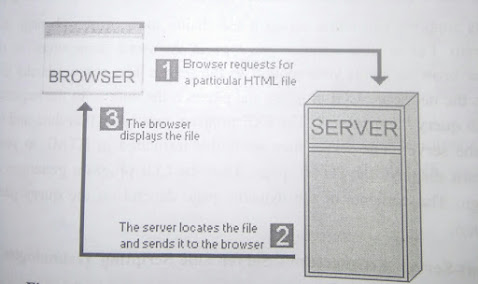_Internet Technology
3341604
Assignment #chap-1
1: Explain client-server architecture.
=>>
-The internet revolves around the client-server architecture.
-Your computer runs software called the client and it interact with other software known as the server
located at remote computer.
-The client is usually a browser such as chrome, internet explorer, Mozilla, etc.
-These protocols helps in accurate transfer of data through request from a browser and responses from the server.
-The World Wide Web, which is a part of the Internet, brings all these protocols under one roof. You can Thus use HTTP, FTP, Telnet, email etc.
-The web employs a connection-less protocol, which means that after every client-server interaction the connection between the two is lost.
Client-server Architecture-Static HTML Pages:
The client requests for an HTML file stores on the remote machine through the server software.
The server locates that file and passes it on the client. The client then displays this file on your machine.
In this case, the HTML page is static. Static pages do not change until the developer modifies them.
Client-Server Architecture - CGI scripts
The scenario is slightly different for CGI applications. Here the server has to do more since CGI programs consume the server machine's processing power.
The CGI program process this data and returns result to the server .and server sends this formatted in HTML to your browser which in turn displays HTML page.
Thus the CGI program generates a dynamic HTML page.
Client-Server Architecture - Server Side Scripting Technologies.
The third case also involves dynamic response generated by the use of server side Technologies.
there are many server side Technologies today
Active Server Pages (ASP) : A Microsoft Technology. ASP pages typically have the extension .asp .
Personal Home Pages (PHP) : An open sources technology. PHP pages typically have .php,.phtml or .php3 file name extensions.
Java Server Pages: .jsp pages contain Java codes and Server Side Includes (SSI): Involves the embedding of small code snippets inside the HTML page.
With these Technologies it has become easier to maintain Web pages especially helpful for large web site. The code is passed to the appropriate interpreter which processes these instructions and generates the final HTML displayed by the browser
2: What is DNS? Explain the hierarchy of Domain Name System
=>> Domain Name Services (DNS) is the service used to convert human readable names of hosts to IP addresses.
Host name are not case sensitive and can contain alphabetic or numeric letters or the hypen. Avoid the underscore.
The Domain Name System (DNS) is a hierarchical naming system for computers, services, or any resource connected to the internet or a private network.
It is basically a large database which resides on various computers and it contains the name and IP addresses of various hosts on the internet and various domains.
"The Domains Name Service is the act of querying the database, and the Domain Name System is the data structure and data itself ."
DNS names are assigned through the Internet Registries by the Internet Assigned Number Authority(IANA).
DNS Hierarchy:- At the top is what is called the root and it is the start of all other branches in the DNS tree. It is designated with a period. Each branch moves down from level to level.
3: Describe in detail Internet Service Provider?
=>>
-Sometimes Internet Service Provider(ISP) referred as as an Internet access Provider (IAP),is a company that offers its customers access to the Internet.
The ISP connects to its customers using a data transmission technology appropriate for delivering Internet Protocol Paradigm, such as dial-up, DSL, cable modem, wireless or Dedicated high speed interconnects.
ISPs may provide Internet e-mail accounts to users which allow them to communicate with one another by sending and receiving electronics messages through their ISP's servers.
ISPs provide services such as remotely storing data files on behalf of their customers.
For users and small businesses, the most popular options dial-up, DSL, broadband Wireless, cable modem, fiber to the premises, and Integrated Services Digital Network.
For customers with more demanding requirements, such as medium-to-large businesses, or other ISPs, DSL, Ethernet, Metro Ethernet, Gigabit Ethernet, Frame Reay, ISDN, ATM, satellite Internet access and synchronous optical networking are more likely to be used.
4: What is DNS? Explain the hierarchy of Domain Name System
=>> Same as Q.2
5: How the ISP will be helpful for providing the service of Internet?
=>>ISPs make it possible for their customers to surf the web, shop online, do business and connect with family and friends. ISPs can also provide other services, including email services, domain registration, web hosting, and browser packages.
The ISP connects to its customers using a data transmission technology appropriate for delivering Internet Protocol Paradigm, such as dial-up, DSL, cable modem, wireless or Dedicated high speed interconnects.
ISPs may provide Internet e-mail accounts to users which allow them to communicate with one another by sending and receiving electronics messages through their ISP's servers.
ISPs provide services such as remotely storing data files on behalf of their customers.
For users and small businesses, the most popular options dial-up, DSL, broadband Wireless, cable modem, fiber to the premises, and Integrated Services Digital Network.







0 Comments